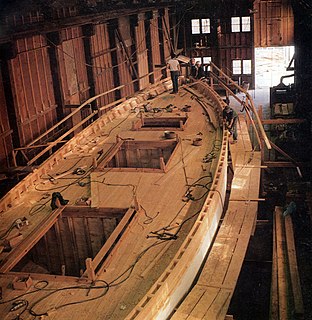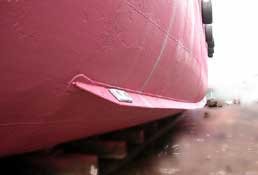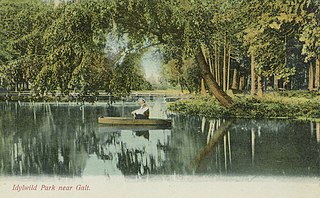
A kayak is a small, narrow watercraft which is typically propelled by means of a double-bladed paddle. The word kayak originates from the Greenlandic word qajaq.

A dory is a small, shallow-draft boat, about 5 to 7 metres or 16 to 23 feet long. It is usually a lightweight boat with high sides, a flat bottom and sharp bows. They are easy to build because of their simple lines. For centuries, dories have been used as traditional fishing boats, both in coastal waters and in the open sea.

On boats and ships, the keel is either of two parts: a structural element that sometimes resembles a fin and protrudes below a boat along the central line, or a hydrodynamic element. These parts overlap. As the laying down of the keel is the initial step in the construction of a ship, in British and American shipbuilding traditions the construction is dated from this event. Only the ship's launching is considered more significant in its creation.

Boat building is the design and construction of boats and their systems. This includes at a minimum a hull, with propulsion, mechanical, navigation, safety and other systems as a craft requires.

The Lightning is a sloop rigged sailing dinghy originally designed by Olin Stephens of Sparkman & Stephens in 1938 and was first sailed on Skaneateles Lake, NY, United States. More than 15,000 Lightnings have been built since then. There are over 500 fleets of Lightnings worldwide, many of which participate in dinghy racing.

A strake is a course of the planking or plating of the hull of a vessel. In a wooden construction it is a strip of planking running longitudinally along the vessel's bottom and sides. In a metal ship it is a course of plating.

Sharpies are a type of hard chined sailboat with a flat bottom, extremely shallow draft, centreboards and straight, flaring sides. They are believed to have originated in the New Haven, Connecticut region of Long Island Sound, United States. They were traditional fishing boats used for oystering, and later appeared in other areas. With centerboards and shallow balanced rudders they are well suited to sailing in shallow tidal waters.

Philip C. Bolger, prolific boat designer, was born and lived in Gloucester, Massachusetts. He began work full-time as a draftsman for boat designers Lindsay Lord and then John Hacker in the early 1950s.
A padded v-hull is a type of high performance watercraft.
The shad boat is a traditional fishing boat which was proclaimed the Official State Historic Boat of North Carolina by the North Carolina General Assembly in 1987. One hundred years earlier, George Washington Creef of Roanoke Island built the first shad boat in North Carolina in the early 1880s. Creef shaped his boat hull from the root ball of Atlantic white cedar, also known as juniper, trees that grew along the shoreline of the pocosin wetland region of southeast Virginia and northeast North Carolina. The boat type is named after the shad which was the type of fish caught from the boats.

The Chesapeake Bay deadrise or deadrise workboat is a type of traditional fishing boat used in the Chesapeake Bay. Watermen use these boats year round for everything from crabbing and oystering to catching fish or eels.

A bilge keel is used to reduce a ship's tendency to roll. Bilge keels are employed in pairs. A ship may have more than one bilge keel per side, but this is rare. Bilge keels increase hydrodynamic resistance to rolling, making the ship roll less. Bilge keels are passive stability systems.
The Kadakkarapally Boat is a shipwreck found near Kadakkarappally, in the Southern India state of Kerala.
Shell plating is the outer-most structure on the hull of a steel or aluminum ship or boat.

The Gull sailing dinghy was designed by Ian Proctor in 1956, originally as a frameless double-chine plywood boat. However, it has been through several incarnations: the wooden Mark I, GRP Mark III, GRP Gull Spirit and GRP Gull Calypso. Today it is popular with sailing schools, especially in the UK.
Oheka II was a private motor yacht built for German investment banker Otto Hermann Kahn by Lürssen in 1927. Capable of 34 knots top speed, she became the blueprint for the Kriegsmarine's Schnellboot.

A flat-bottomed boat is a boat with a flat bottomed, two-chined hull, which allows it to be used in shallow bodies of water, such as rivers, because it is less likely to ground.
The Lürssen effect, used in the design of high-speed boats, is a reduction in wave-making resistance provided by two small rudders mounted on each side of the main rudder and turned outboard. These rudders force the water under the hull outward, lifting the stern, thus reducing drag, and lowering the wake height, which “requires less energy, allowing the vessel to go faster.” The effect was discovered by the German shipbuilding company Lürssen Werft based in Bremen-Vegesack. The Lürssen effect is best remembered for its use during the Second World War in the various classes German "Schnellboot," or fast torpedo attack boats.
















